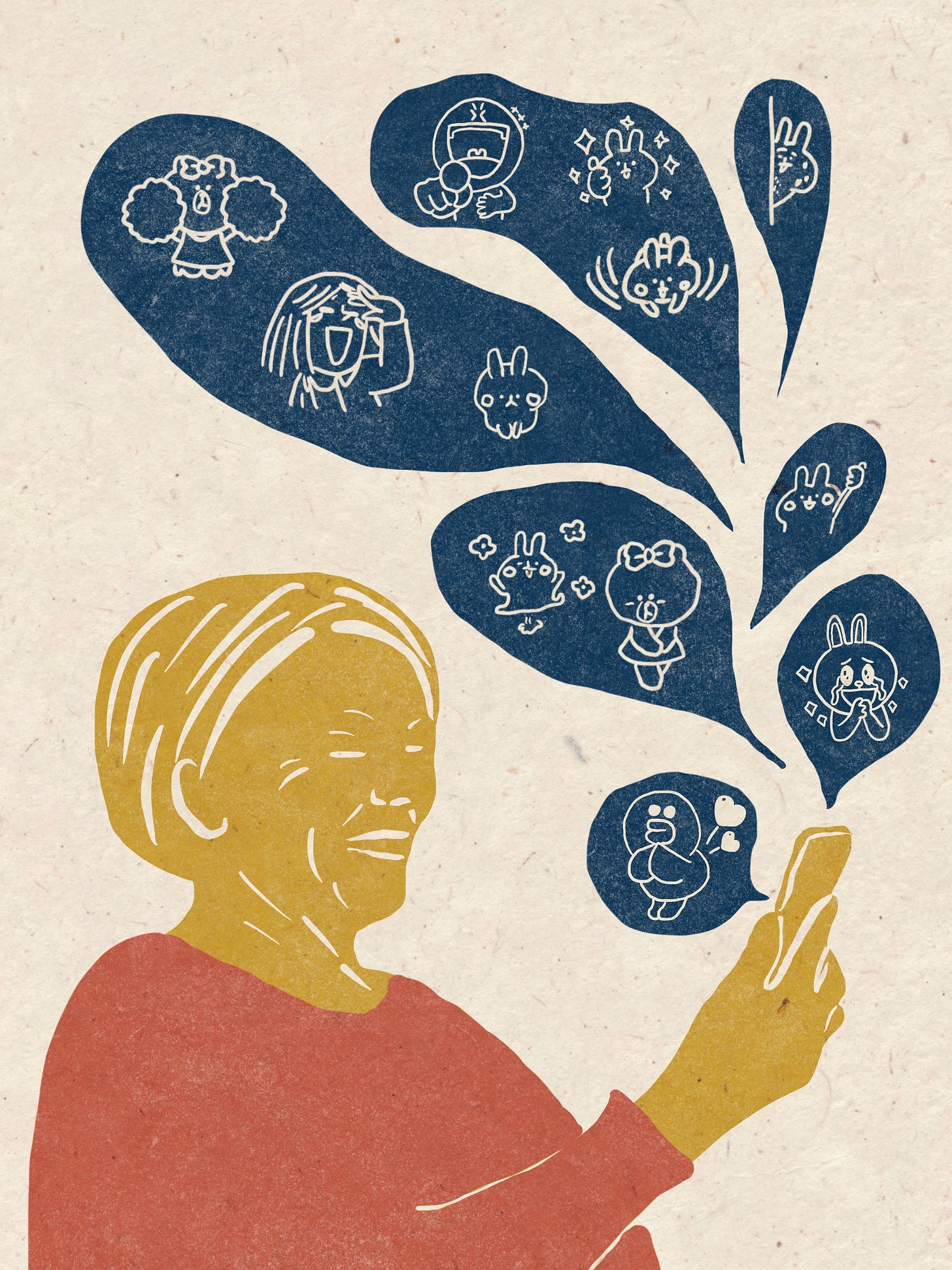Publication day! "Ageing with Smartphones in Japan: care in a visual digital age"
My book is available to read now for free!
I am thrilled to announce the release of my new book, Ageing with Smartphones in Japan, published today by UCL Press. This book represents the culmination of 16 months of immersive ethnographic research conducted in both urban Kyoto and rural Kōchi Prefecture. Through the stories of individuals I met, I explore the profound and often surprising ways in which older adults in Japan, one of the world’s most rapidly ageing societies, are beginning to adopt and integrate smartphones into their daily lives.
Japan has long been at the forefront of discussions about ageing, given its status as one of the most ageing countries globally. With nearly 30% of its population aged 65 and older, Japan presents an ideal context for examining how technology influences the lives of older adults. Over the past decade, smartphones have become ubiquitous tools for communication and social interaction across the globe. The fieldwork for this book was conducted during 2018-2019 as older adults were beginning to widely adopt the device, revealing the smartphone’s impact on areas such as friendship, gendered labour, multigenerational living, internal migration, health, and even the very purpose of life—a concept known as ikigai in Japanese.
Ageing ‘well’
A central question has emerged in much of the recent anthropological research on ageing: what does it mean to ‘age well’ and how do people navigate the challenges that may come with advancing years while balancing autonomy and dependency? For many of my research participants ‘ageing well’ was framed in terms of maintaining a sense that they were staving off any burden that they might cause other people – that they were capable of taking care of themselves. Digital technologies are emerging as a key way in which people are taking care of themselves and others.
However, this framing of ageing individuals as burdensome, and the focus on individual responsibility, requires unpacking and contextualising, particularly given the precarious conditions of neoliberal capitalism in which many Japanese find themselves today. Older people often endeavoured to remain socially embedded through the act of caring for others and contributing to their communities, especially when they might need increased care themselves. Many of my participants felt they could contribute by helping to care for still older people, filling gaps left by weakening state welfare and a diminishing birth rate.
Gendered labour
Another key focus of the book is the complex relationship between smartphones and gendered labour, particularly in the context of care. In Japan, caregiving has traditionally been seen as women’s work, often placing a significant burden on middle-aged women who care for both their aging parents and in-laws. The smartphone emerges as a double-edged sword in this context—on the one hand, it provides a platform for women to seek support, share experiences, and organise care networks; on the other, I found that the rejection of the smartphone by many older men reinforces the expectation that women should be the primary caregivers, extending the arena of care into the digital sphere.
Through the experiences of the women and men I met during my research, I examine how older adults negotiate care and use smartphones to either challenge or perpetuate traditional gender norms. For some, the smartphone becomes a lifeline, offering a space to find solace in friendships, and providing a safety net in times of crisis. For others, it represents a shift towards communication with no heart, posing a threat to face-to-face interaction.
Living together, apart
With the decline of multigenerational households, where older adults traditionally lived with their children and grandchildren, and the migration of young people to cities from rural areas, smartphones play a crucial role connecting families living apart. These devices can help bridge generational gaps. However, I found that technology is also being used within domestic spaces to insert distance into relationships, to avoid the burden of over-closeness and facilitate privacy. Through an account of staying in a ‘two generational home’, where the older generation lived in a connected apartment on the ground floor of a family house in Osaka, I document how the smartphone as a space of care mirrors the ways in which the design of physical homes can facilitate both independence and connection, closeness and distance.
Outside of this two-month home stay, the majority of my fieldwork was conducted in the city centre of Kyoto, and in a rural town called Tosa-chō in Kōchi Prefecture. I decided to include a rural fieldsite since rural areas, with their extreme ageing populations, represent the ‘face’ of super-ageing Japan. In Tosa-chō 45 per cent of the population are aged over 65, compared with the national average of 28 per cent. The national population of Japan is predicted to reach similar proportions by 2065. In the next 30 years the speed of ageing in Asia-Pacific countries will be unprecedented, with 11 countries being predicted to reach ‘super-ageing’ status. Rural regions therefore offer glimpses into the demographic future not only of Japan, but of much of the world. While statistics such as these offer some indication of what the future holds at a population and societal level, only by spending time in rural areas can one appreciate how these demographic shifts affect everyday life for individuals across generations.
Life purpose and mutual support
The concept of ikigai, or life purpose, is deeply ingrained in Japanese culture and is often associated with maintaining health in later life. In Ageing with Smartphones in Japan, I show how this can be a contentious term for people in mid-life, who may experience it as a kind of pressure, akin to the ‘successful ageing’ ideology. I show how people are shaping their own meanings of ikigai through the sharing of visual and textual media online. I found that it was often care itself that gave people the greatest sense of meaning and purpose.
In the city centre of Kyoto where new hotels and boutique coffee shops spring up within weeks, replacing old family homes, I found that older residents were nostalgic for a time when their local communities were thriving. It is not only older residents that keenly sense this decline. I explore how the notion of yui, or mutual support, is drawing migrants from cities to rural areas who are in search of community rooted in physical proximity. However, ironically I found that it is their digital networks that make a transition to rural life viable.
Visual communication
One of the central themes of Ageing with Smartphones in Japan is the way smartphones are impacting social relationships. In Japan, where non-verbal face-to-face interaction is fundamental to how people express themselves, the rise of digital communication presents both opportunities and challenges, especially for older adults.
The book delves into how digital visual communication—through apps like Line and Instagram—is transforming the way people connect with each other. This shift toward image-based communication opens new avenues for expressing emotions and sharing experiences. It also allows older adults to maintain proximity with loved ones, even when geographical distance separates them.
A visual approach to ethnography
Recognising the importance of visual communication in the digital age, I incorporated a series of graphic methodological experimentations into the book. These include co-created comics, participant drawings, and my own fieldwork sketches and imaginative illustrations. I hope that these visual elements not only enrich the narrative but also offer readers a deeper, more sensory engagement with the material.
By embracing graphic methods, the book responds to the challenges posed by the shift toward digital images in communication. Digital and analogue drawings provide a lens through which to view the experiences of older adults as they navigate the complexities of ageing in a rapidly changing technological landscape.
Read for free
The publication of this book as open access by UCL Press is particularly meaningful to me, as it is available to anyone, anywhere, free of charge, as are the rest of the books in the Ageing with Smartphones series. I hope that the stories of the people I got to know will reach as wide an audience as possible.
Ageing with Smartphones in Japan is not just a book about technology; it is a study of human resilience, adaptation, and the desire for connection in an increasingly digital world. I have aimed to offer a nuanced perspective on ageing, one that acknowledges both the potential of technology to enhance the lives of older adults and the challenges that remain.
I am honoured and truly thrilled to have received the following appraisals from esteemed scholars in the field:
‘An excellent and thoughtful book on ageing in Japan, focusing on the use of smartphones, but not limited to it. The truly innovative use of graphic and multimodal ethnography is not only effective but also showcases such methods for others.’ - Iza Kavedžija, University of Cambridge.
‘Highly original, extensively researched and thought-provoking, Haapio-Kirk rewards the reader with lively story-telling and beautifully crafted images that invite another level of sensory and emotional engagement – an impressive achievement.’ - Jason Danely, Oxford Brookes University.
Over the course of my research, I was privileged to be welcomed into the lives of many people across Japan. I hope that this book will do justice to the trust they placed in me, and will inspire further exploration into the ways in which older adults around the world are redefining later life. As I embark on new research in Finland that continues to explore the intersection of digital technologies, wellbeing and ageing, I am immensely grateful for the opportunities my previous fieldwork in Japan afforded me and to everyone who helped me along this journey.
Download the book for free or purchase a print copy here.
Save 20% on print copies when you use the code UCL24LSM581L at www.uclpress.co.uk
Code expires 31 Jan 2025. Excludes purchases from/deliveries to North America. North American customers, please visit press.uchicago.edu.
All images by Laura Haapio-Kirk.










